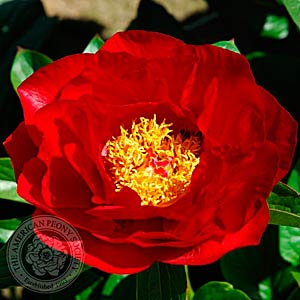 The American Peony Society has selected the peony ‘The Mackinac Grand’ to receive the APS Gold Medal Award and to be the 2014 Peony of the Year.
The American Peony Society has selected the peony ‘The Mackinac Grand’ to receive the APS Gold Medal Award and to be the 2014 Peony of the Year.
‘The Mackinac Grand’ was originated by David L. Reath in 1992. Blooming early to midseason, this medium-sized plant has warm red, semi-double and ruffled blooms. On sunny days, the flowers exhibit a gamut of red, from deep shades in the shadows to fiery red highlights and the sparkle of sunlight from the petal’s gloss. From afar, the color has great carrying power and always attracts attention. The bush itself has an open, somewhat spreading habit, with strong, rigid stalks. ‘The Mackinac Grand’ is a strong grower and reliable bloomer; performance improves with age and stem increase.
